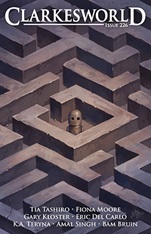“Missing Helen” by Tia Tashiro
“Welcome to Kearney” by Gary Kloster
“Bits and Pieces on This Floor” by Eric Del Carlo
“Hunter Harvester” by Bam Bruin
“The Walled Garden” by Fiona Moore”
“Serpent Carriers” by K. A. Teryna
“A Land Called Folly” by Amal Singh
Reviewed by Victoria Silverwolf
In “Missing Helen” by Tia Tashiro, a divorced man tells his ex-wife that he intends to marry her clone. The clone was created years ago, when the woman needed money, by a company that supplies clones to childless couples. She eventually meets her younger duplicate.
Multiple flashbacks tell of the woman’s unhappy youth and her decision to sell the rights to her clone, as well as her courtship, marriage, and divorce. The heart of the story is the meeting of the two women. The ex-husband seems to be just a plot device for them to come together.
The author creates a convincing future world. The story is narrated in second person, directed to the older woman. When I found out who is telling the story, revealed late in the text, it made me wonder how the narrator could know about her experiences in such detail.
In “Welcome to Kearney” by Gary Kloster, a man chooses to live alone, working as a caretaker for an abandoned community that is now a tourist site. He repairs a robot that has become sentient and left its owners. A robot with full consciousness and free will must be destroyed, so together they face the deadly robot sent after it.
I may have made this story sound melodramatic, and there is a scene of violent action. However, it is mostly about the relationship between the man and the robot. Both are complex, fully developed characters. Their interaction leads to a bittersweet conclusion.
The narrator of “Bits and Pieces on This Floor” by Eric Del Carlo is part of a team assigned to remove the few remaining inhabitants of a colony world. The company in charge of the planet has taken all its valuable resources, and the devices that give it a breathable atmosphere are being dismantled. His encounter with one of the last residents to vacate the planet gives him insight into his past.
Despite depicting a future of interstellar travel and highly advanced technology, this is mostly an intimate story. It deals largely with the narrator’s relationship (or lack thereof) with his father. There are also mentions of a new form of art, using fungi found on the planet, and the narrator’s relationship with an assistant.
The title of the story is appropriate, as it does seem to consist of bits and pieces of various themes. Perhaps these do not always come together to make an entirely satisfactory whole.
“Hunter Harvester” by Bam Bruin takes place on a planet where human colonists survive on a plant that contains all the nutrients they need. The world is inhabited by aliens who encourage the humans to harvest some of the plants, but forbid them from taking others. The narrator discovers the nature of the relationship between the aliens and the plants.
The story is told to the narrator’s unborn child. In a certain way, this reflects the planet’s unique ecology. It might also be seen as a gimmick. In any case, the most interesting aspect is the depiction of alien biology.
“The Walled Garden” by Fiona Moore is one of a series of stories about the lives of villagers and nomads after security robots were reprogrammed in a way that caused them to rebel against their owners. The text alternates sections of narrative dealing with the main character’s survival in the wilderness soon after this event, and those set decades later, when she helps villagers construct the structure mentioned in the title.
Readers who are familiar with previous stories in the series will appreciate this entry more than those who are not. The narrative structure makes the story read like sections of a novel cut up and pasted together. There are some intriguing premises, such as the fact that robots are creating their own unusual forms of art, but these are not fully developed. Overall, this seems like a work in progress.
“Serpent Carriers” by K. A. Teryna is translated from Russian by Alex Shvartsman. It is a very difficult story to describe. It has something to do with a galactic empire using genetics to create warriors for its endless battles, as well as an alien fungus that causes humans to have shared consciousness.
Even this greatly oversimplified synopsis is likely to be misleading and inaccurate. I found the story very hard to follow. Part of this has to do with the author’s constant use of metaphors. As Samuel R. Delany has pointed out, readers of science fiction are likely to take these literally, leading to confusion. In addition to this, many words are used to mean something other than their normal definitions. In this story, for example, a yak is not an animal, but a large recycling machine.
The narrative is structured as three stories told by an elderly man to a young woman. Adding to the layers of narration, part of one of these stories is imagined as a stage musical. This complex technique makes for a dense work requiring careful reading. Readers need to be very patient to fully appreciate this fairly lengthy novelette.
In “A Land Called Folly” by Amal Singh, a young man leaves home for a colony planet, falls in love but breaks up with his girlfriend, and returns home to be with his dying grandfather.
Starting with the main character as a young child, and taking him to the middle of his twenties, this relatively brief tale can be read as a miniature bildungsroman, as the protagonist matures emotionally. The futuristic background, seen through the eyes of characters from India, is interesting, but the use of second person narration adds little.
Victoria Silverwolf had a busy night at work.
 Clarkesworld #226, July 2025
Clarkesworld #226, July 2025